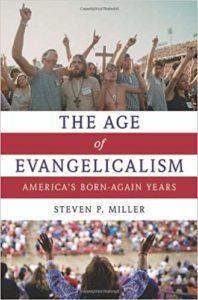
The Age of Evangelicalism: America’s Born-Again Years
Reviewed by Cody R. Hawley, Communication, University of South Florida
When George Gallup dubbed 1976 the year of the evangelical, he foreshadowed and promoted an increased evangelical involvement in politics. Jimmy Carter, with casual talk of his born-again faith, established its relevance in the public mind and reporters were often scrambling to understand this apparent religious ubiquity. Yet few observers could have predicted just how dominant a force evangelicals would become in the following decades. Historian Steven Miller reconsiders this influence by guiding the reader through a rich narrative of evangelicalism’s place in American society over the past half century. The pervasive influence of evangelicalism, he argues, is too great to be termed a mere subculture; it surpasses the label. Instead it might be more useful to consider the previous four decades as constituting a distinct Age of Evangelicalism.
To explore this thesis Miller investigates how politicians, academicians and cultural personalities came to reflect on evangelicalism’s increased presence with complex and competing responses. Miller makes the compelling case that evangelical history is more telling when it is not limited to self-identifying evangelicals; by widening the inquiry to include non-evangelical actors as central agents in the cultural drama the profound influences of evangelicalism’s deep infusion into public life emerges. The result of this approach is an enthralling tale, assisted by Miller’s natural penchant for story-telling that manages to be refreshing while recounting familiar events.
To gauge the extent of evangelicalism’s impact, Miller embraces an impressive diversity of sources. For example the reader is treated to a tale of sociologists such as Peter Berger proposing his secularization thesis and then slowly recanting in the face of accelerating religiosity and Robert Bellah’s critique of Civil Religion; this is paralleled with Bob Dylan’s surprising born-again profession of faith, Hal Lindsey’s apocalyptic Late Great Planet Earth, Marabel Morgan’s anti-feminist The Total Women, and President Nixon’s White House drama – all in the same chapter!
Miller structures his book into six chapters largely revolving around elections, with the first two chapters describing evangelicalism’s rise in the seventies and then devoting one chapter each to every proceeding decade. In chapter 1 Miller places the beginning of the “age” of evangelicalism just prior to the fervor of Richard Nixon’s Watergate scandal. Cold War religiosity had aroused an acceptable display of civic spirituality often in the form of civil religion. After Nixon’s resignation, evangelicalism came to assume part of the place civil religion had created during a time of self-examination. In chapter 2 Miller hones in on how the Evangelical Left and Right attempted to harness this new political enthusiasm. The heightened visibility of evangelicalism was undeniable but it was still unknown what the political implications of it would be. Jimmy Carter gave initial evidence that politicalized evangelicalism may assist the Left. Yet many evangelicals were soon perturbed that Carter’s faith did not necessarily translate into desirable social policies. Powerful voices in the Evangelical Right such as Jerry Falwell, Francis Schaeffer, and Pat Robertson emerged as his harshest critics. By the 1980s evangelical conservatives mobilized into a powerful religious coalition.
Chapter 3 explores the drama of Reagan-era evangelicalism. To many, the power of the Religious Right threatened to erode any semblance of church and state separation. While the Reagan administration’s nods to the Evangelical Right often lacked substance, the perceived muscle of the Religious Right led to an anti-evangelical panic. The Left, alarmed at this rightward shift, tried to attack the Christian Right without seeming to discredit all Christians and evangelicals, lest they offend moderate and progressive evangelicals that would be more sympathetic to their cause. The Evangelical Right meanwhile started blurring the same distinctions in the public mind. This leads well into chapter 4, containing both the George H. W. Bush and Bill Clinton administrations. Metaphors such as the “culture wars” and the “naked public square” came to dominate the way events were framed, becoming imprinted on political America’s interpretive consciousness. Politicians and scholars alike were forced to debate the proper place of religion. Miller here devotes sizable space to academic commentary of the times. George Marsden, Mark Noll, Martin Marty, and others – whom Miller terms the “Thoughtful Evangelicals” – produced superb evangelical scholarship with an important impact on intellectual society.
The Climax of the “Age of Evangelicalism” in Miller’s narrative is the presidency of George W. Bush, discussed in chapter 5. Here we observe the triumphs and extremes of evangelicals’ ascension: Bush’s compassionate conservatism, the establishment of the House Office of Faith-Based and Community Initiatives, and an executive order establishing exceptions for doctrine-based hiring. Furthermore evangelicalism thrived in mainstream popular culture with such artifacts as Rick Warren’s Purpose Driven Life and Tim Lahaye and Jerry Jenkins’ outrageously successful Left Behind premillennialist thrillers. These excesses, Miller argues, along with Bush’s plummeting popularity in his final term, led to a “Second Evangelical Scare” that fanned more anti-Evangelical Right sentiment and mobilized the Evangelical Left. Barak Obama in his 2008 campaign capitalized on this opportunity, as Miller explores in the final chapter. Assisted by disenchantment with Bush as well as the Democratic Party’s renewed attempts to narrow the perceived God gap, “Obamagelicals” became a significant source of support in his successful presidential campaign. The hope for change and Obama’s conciliatory, respectful tone on issues such as abortion appealed to moderate evangelicals, allowing Obama to survive the potentially damning Jeremiah Wright controversy. Miller argues that the shift between 2006 and 2008 was rapid and drastic, resulting in a partial unraveling of the evangelical alliance and renewal of the Evangelical or Progressive Left.
By the 2012 election, however, Miller claims “the Age of Evangelicalism was winding down” (161). As he argues in the epilogue, neither candidate exemplified traditional evangelical underpinnings and by in large, religious issues played a minor role. Miller sees a movement among conservative Christians toward ecumenism and a wane in their overall political authority. There seems to be a simultaneous fragmentation and exhaustion. These points collectively are taken to support his thesis that the previous half-century, as an Age of Evangelicalism, reached in apex in the early Bush years, but soon grew into disenchantment and changes that may have portended the twilight of the Age of Evangelicalism.
The story is often familiar and will not introduce much new material to the expert on American evangelicalism. Readers looking for completely new or undiscovered ideas may be disappointed. But Miller excels in reframing the narrative in such a way that encourages readers to see evangelicalism as more than just a movement limited to Christians; his narrative shows that evangelicals have, for better or for worse, occupied a central position in the American experience; one cannot properly understand recent American events without seeing the connections to this Christian movement.
Age of Evangelicalism is for those looking for an introduction to the born-again phenomena in American culture as well as readers looking for a forceful historical argument that places evangelicalism above the cultural periphery and into the heart of American experience. Miller is a gifted writer with a knack for flowing a diverse cast into a smooth flowing narrative, which allows Age of Evangelicalism to be surprisingly brief for the material it covers. By Miller’s effortless blending of popular culture, political drama, and intellectual inquiry the reader is presented to the disparate ways non-evangelicals and evangelicals alike came to terms with born-again identity.
Yet the book’s brevity is also its weakness. By covering so much territory Miller is forced to gloss over or forego analyses of other social factors that may have contributed to the story. Oftentimes, it seems for the sake of flow the narrative omits minute and detailed analysis of the American events. The work would have especially benefitted from more space dedicated to Evangelical Left in the heart of the book. The account in emphasizing conservative evangelicalism’s strength at times relegated the Evangelical Left to the back seat. But a completely comprehensive account was not the primary aim of the book; making a strong case that evangelicalism has been positioned at the core of American consciousness was more important and he is convincing in that claim.
If one accepts Miller’s argument that America has been entrenched in an Evangelical Age, the reader will be prompted to wonder what is next. Evangelicalism is now forced to redefine itself. Most readers will acknowledge that evangelicalism has changed and entered a new stage; however, disagreement will arise about whether it should be considered the end of an age. Evidence abounds that evangelical presence will continue to dominate the upcoming years. The recent Hobby Lobby Supreme Court case, questions of religious freedom and pluralism, and debates over LGBTQ rights are but a few examples; popular media has only increased its investments in evangelical culture with movies such as Noah, Son of God, God’s Not Dead, Exodus, and Heaven is For Real produced in the past few years. Christian rapper Lecrae saw his distinctly Christian album rank number one on the Billboard charts. American evangelicalism may be in a transitory stage but perhaps we all must wait and see whether we are witnessing a finale of an age or a new act.























